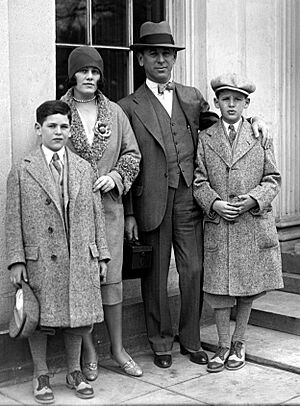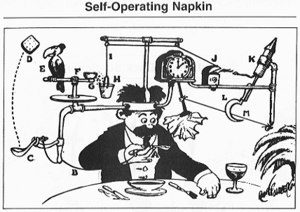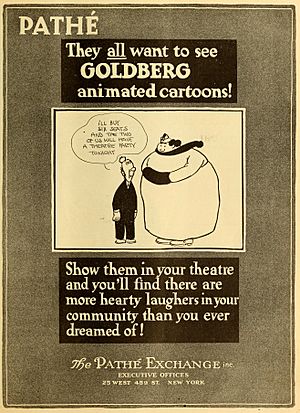Rube Goldberg facts for kids
Quick facts for kids
Rube Goldberg
|
|
|---|---|

c. 1916
|
|
| Born |
Reuben Garrett Lucius Goldberg
July 4, 1883 San Francisco, California, U.S.
|
| Died | December 7, 1970 (aged 87) New York City, U.S.
|
| Resting place | Mount Pleasant Cemetery in Hawthorne, New York |
| Alma mater | UC Berkeley |
| Occupation | Engineer, sculptor, news reporter, cartoonist |
| Known for | Rube Goldberg machines |
| Spouse(s) |
Irma Seeman
(m. 1916) |
| Children | 2, including George W. George |
Reuben Garrett Lucius Goldberg (born July 4, 1883 – died December 7, 1970), known as Rube Goldberg, was an American cartoonist, artist, and inventor. He was famous for drawing cartoons that showed very complex machines doing simple tasks in a silly, roundabout way.
These cartoons led to the phrase "Rube Goldberg machines." This term describes any overly complicated device or process. Rube Goldberg received many awards. These included a Pulitzer Prize in 1948 for his political cartoons. He also helped start the National Cartoonists Society. An award for top cartoonists, the Reuben Award, is named after him. Today, there are even international contests where people build their own Rube Goldberg machines.
Personal life
Rube Goldberg was born in San Francisco, California. His parents were Max and Hannah Goldberg. He was one of seven children. Rube started drawing when he was only four years old. He took drawing lessons from a local sign painter.
In 1916, Rube Goldberg married Irma Seeman. They lived in New York City and had two sons, Thomas and George. During World War II, Rube asked his sons to change their last name. This was because some people disliked him for his political cartoons. His sons chose the last name George to stay connected as a family.
Career
Rube Goldberg's father wanted him to be an engineer. Rube studied engineering at the University of California, Berkeley. He graduated in 1904. He worked as an engineer for the city of San Francisco for six months.
But Rube loved drawing more. He left his engineering job to become a sports cartoonist for a newspaper. In 1907, he moved to New York City. There, he worked for the New York Evening Mail.
Rube's first popular comic strip was Foolish Questions, which started in 1908. His famous invention cartoons began in 1912. His cartoons became very popular across the country. By 1915, he was one of America's most famous cartoonists.
In 1916, Rube Goldberg made seven short animated films. These films showed funny everyday situations. He also drew many other comic strips. It's thought that he created about 50,000 cartoons in his lifetime!
The cartoon series that made him truly famous was The Inventions of Professor Lucifer Gorgonzola Butts, A.K.. In this series, Rube drew detailed plans for his funny, complicated "inventions." The character Professor Butts was inspired by Rube's own engineering professor, Frederick Slate. Professor Slate once gave his students a silly task: to build a scale that could weigh the Earth! This mix of serious and ridiculous ideas inspired Rube's work.
From 1938 to 1963, Rube Goldberg worked as an editorial cartoonist. He drew cartoons about politics and news. He won the 1948 Pulitzer Prize for Editorial Cartooning for a cartoon called "Peace Today". After retiring from cartooning, Rube Goldberg started a new career as a sculptor. He mostly created busts, which are sculptures of a person's head and shoulders.
Cultural legacy
Rube Goldberg's cartoons were so popular that people started using his name to describe things. By 1928, the term "Rube Goldberg" was used to mean something "fantastically complicated" or "deviously complex and impractical." When people say "Rube Goldberg machine," they are talking about the crazy inventions he drew.
Other countries have similar terms. In the UK, they say "Heath Robinson" for complicated machines. In Denmark, they say "Storm P.-machine" after cartoonist Robert Storm Petersen.
In 1995, Rube Goldberg's work was honored with a U.S. postage stamp. It showed his 1931 "Self-Operating Napkin" invention.
The Rube Goldberg Machine Contest started in 1949 at Purdue University. It became a national competition in 1989. In these contests, teams build complicated machines to do a simple task. The machine must use at least 20 steps and no more than 75 steps. It must also be in the style of Rube Goldberg's drawings.
Film and television
Rube Goldberg wrote the first movie for The Three Stooges called Soup to Nuts (1930). The movie featured his machines. Rube himself even appeared in it!
In the 1962 movie Hatari!, a device to catch monkeys is called a "Rube Goldberg."
Many educational TV shows have featured Rube Goldberg devices. These include Sesame Street, Vision On, and The Electric Company. They used these machines to teach about cause and effect.
Lots of other movies and cartoons have shown complicated machines doing simple things. Some examples are Looney Tunes, Tom and Jerry, Wallace and Gromit, Back to the Future, and the Home Alone movies. The Final Destination movies are also known for characters dying in Rube Goldberg-like ways.
The 2003 Honda commercial "The Cog" was a famous example of a real-life Rube Goldberg machine. The band OK Go also made a music video in 2010 called "This Too Shall Pass – RGM Version." It features a huge Rube Goldberg machine that shoots paint at the band members.
Games
Both board games and video games have been inspired by Rube Goldberg's creations. The classic 1960s board game Mouse Trap is a great example. The The Incredible Machine video games from the 1990s also let players build their own complex contraptions.
In 1909, Rube Goldberg even invented a game called "Foolish Questions." It was based on his popular cartoon of the same name. More recently, a game called Rube Works: The Official Rube Goldberg Invention Game was released in 2013.
See also
 In Spanish: Rube Goldberg para niños
In Spanish: Rube Goldberg para niños
- Chindōgu
- Domino effect
- Frederick Rowland Emett
- Jean Tinguely, a Swiss artist who made Rube Goldberg–like sculptures
- PythagoraSwitch





